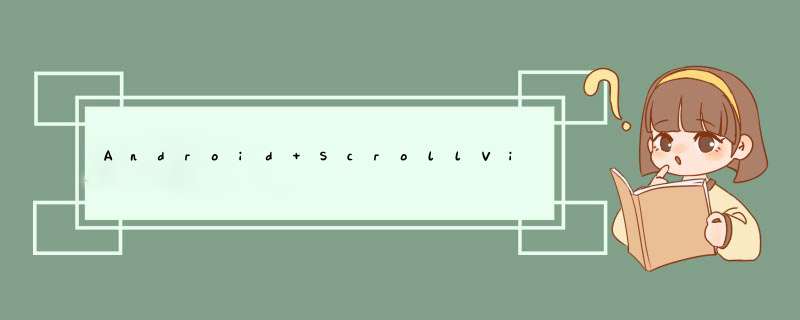
AndroID ScrollVIEw实现反d效果
自定义ScrollVIEw控件:
/** * ScrollVIEw反d效果的实现 */ public class BounceScrollVIEw extends ScrollVIEw { private VIEw inner;// 孩子VIEw private float y;// 点击时y坐标 private Rect normal = new Rect();// 矩形(这里只是个形式,只是用于判断是否需要动画.) private boolean isCount = false;// 是否开始计算 public BounceScrollVIEw(Context context,AttributeSet attrs) { super(context,attrs); } /*** * 根据 XML 生成视图工作完成.该函数在生成视图的最后调用,在所有子视图添加完之后. 即使子类覆盖了 onFinishInflate * 方法,也应该调用父类的方法,使该方法得以执行. */ @OverrIDe protected voID onFinishInflate() { if (getChildCount() > 0) { inner = getChildAt(0); } } /*** * 监听touch */ @OverrIDe public boolean ontouchEvent(MotionEvent ev) { if (inner != null) { commOntouchEvent(ev); } return super.ontouchEvent(ev); } /*** * 触摸事件 * * @param ev */ public voID commOntouchEvent(MotionEvent ev) { int action = ev.getAction(); switch (action) { case MotionEvent.ACTION_DOWN: break; case MotionEvent.ACTION_UP: // 手指松开. if (isNeedAnimation()) { animation(); isCount = false; } break; /*** * 排除出第一次移动计算,因为第一次无法得知y坐标, 在MotionEvent.ACTION_DOWN中获取不到, * 因为此时是MyScrollVIEw的touch事件传递到到了ListVIEw的孩子item上面.所以从第二次计算开始. * 然而我们也要进行初始化,就是第一次移动的时候让滑动距离归0. 之后记录准确了就正常执行. */ case MotionEvent.ACTION_MOVE: final float preY = y;// 按下时的y坐标 float NowY = ev.getY();// 时时y坐标 int deltaY = (int) (preY - NowY);// 滑动距离 if (!isCount) { deltaY = 0; // 在这里要归0. } y = NowY; // 当滚动到最上或者最下时就不会再滚动,这时移动布局 if (isNeedMove()) { // 初始化头部矩形 if (normal.isEmpty()) { // 保存正常的布局位置 normal.set(inner.getleft(),inner.gettop(),inner.getRight(),inner.getBottom()); } Log.e("jj","矩形:" + inner.getleft() + "," + inner.gettop() + "," + inner.getRight() + "," + inner.getBottom()); // 移动布局 inner.layout(inner.getleft(),inner.gettop() - deltaY / 2,inner.getBottom() - deltaY / 2); } isCount = true; break; default: break; } } /*** * 回缩动画 */ public voID animation() { // 开启移动动画 TranslateAnimation ta = new TranslateAnimation(0,normal.top); ta.setDuration(200); inner.startAnimation(ta); // 设置回到正常的布局位置 inner.layout(normal.left,normal.top,normal.right,normal.bottom); Log.e("jj","回归:" + normal.left + "," + normal.top + "," + normal.right + "," + normal.bottom); normal.setEmpty(); } // 是否需要开启动画 public boolean isNeedAnimation() { return !normal.isEmpty(); } /*** * 是否需要移动布局 inner.getMeasuredHeight():获取的是控件的总高度 * * getHeight():获取的是屏幕的高度 * * @return */ public boolean isNeedMove() { int offset = inner.getMeasuredHeight() - getHeight(); int scrollY = getScrollY(); Log.e("jj","scrolly=" + scrollY); // 0是顶部,后面那个是底部 if (scrollY == 0 || scrollY == offset) { return true; } return false; } } 实现反d效果:
<com.techrare.vIEw.BounceScrollVIEw androID:layout_wIDth="fill_parent" androID:layout_height="fill_parent" androID:background="@color/tab_chart_bg" androID:scrollbars="none" > <linearLayout androID:layout_wIDth="fill_parent" androID:layout_height="match_parent" androID:gravity="center_horizontal" androID:orIEntation="vertical" androID:paddingleft="20dp" androID:paddingRight="20dp" > <span > </span><!-- 这里可以尽情的布局 --> </linearLayout> </com.techrare.vIEw.BounceScrollVIEw>
以上就是 AndroID ScrollVIEw实现反d效果的实例的讲解,本站关于AndroID开发的文章还有很多,欢迎大家搜索查阅,感谢阅读,希望能帮助到大家,谢谢大家对本站的支持!
总结以上是内存溢出为你收集整理的Android ScrollView实现反d效果的实例全部内容,希望文章能够帮你解决Android ScrollView实现反d效果的实例所遇到的程序开发问题。
如果觉得内存溢出网站内容还不错,欢迎将内存溢出网站推荐给程序员好友。
欢迎分享,转载请注明来源:内存溢出

 微信扫一扫
微信扫一扫
 支付宝扫一扫
支付宝扫一扫
评论列表(0条)